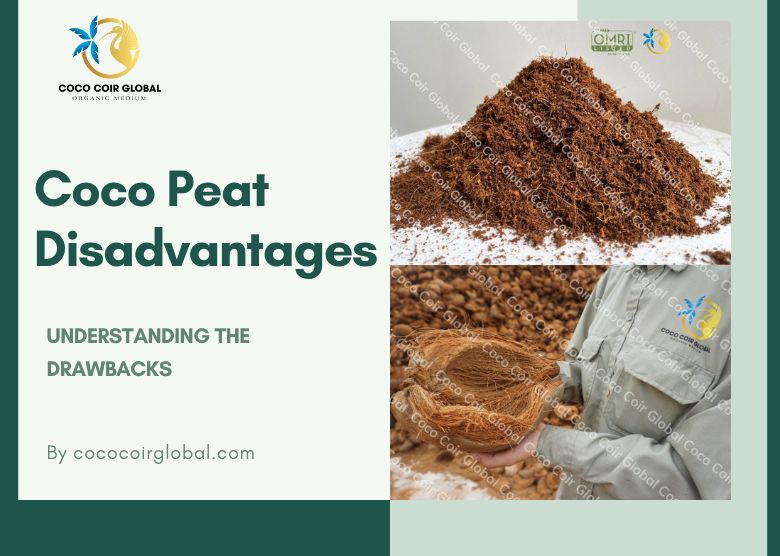Sphagnum Peat Moss vs Coco Coir: Which Growing Medium is Best for Your Plants?

When it comes to choosing the right growing medium for your plants, two popular options stand out: sphagnum peat moss and coco coir. Each of these materials offers unique benefits and drawbacks, influencing not only plant growth but also environmental sustainability. Sphagnum peat moss is renowned for its moisture retention and acidity, making it a favorite among gardening enthusiasts. In contrast, coco coir, derived from coconut husks, boasts superior aeration and is considered a more eco-friendly alternative. In this article, we will explore the characteristics of each medium, helping you determine which one aligns best with your gardening goals and the needs of your plants.
Sphagnum Peat Moss vs Coco Coir: A Comprehensive Comparison
Sphagnum peat moss and coco coir are two popular substrates used in gardening and horticulture, each with its unique properties and advantages. Sphagnum peat moss, derived from decomposed sphagnum moss, is known for its water retention capabilities and acidic pH, making it ideal for plants that thrive in moist conditions. In contrast, coco coir, made from the fibers of coconut husks, is praised for its sustainability and neutral pH, providing excellent aeration and drainage. While both materials can be used for seed starting and potting mixes, the choice between them often depends on the specific needs of the plants being cultivated and the environmental considerations of the gardener.
Water Retention Properties
Sphagnum peat moss has an exceptional ability to retain water, holding up to 20 times its weight in moisture. This makes it an excellent choice for plants that prefer consistently moist conditions. Coco coir, while also proficient in water retention, typically holds less water than peat moss but allows for better drainage. This property of coco coir helps to avoid over-saturation, which can be detrimental to plant roots. Understanding the specific water needs of your plants will help determine which substrate is more suitable for your gardening needs.
Sustainability and Environmental Impact
Coco coir is often hailed as a more sustainable alternative to sphagnum peat moss, which is harvested from delicate peat bogs that can take centuries to form. The production of coco coir utilizes by-products from the coconut industry, promoting waste reduction. In contrast, the extraction of peat moss can lead to habitat destruction and increased carbon emissions. Choosing coco coir supports environmentally-friendly practices and reduces reliance on non-renewable resources, making it an appealing choice for eco-conscious gardeners.
pH Levels and Nutrient Content
Sphagnum peat moss generally has a lower pH, typically ranging between 3.5 to 4.5, which can benefit acid-loving plants like azaleas and blueberries. On the other hand, coco coir has a neutral pH, around 5.5 to 6.5, making it versatile for a broader range of plants. The nutrient content of each substrate also varies; while peat moss is low in nutrients, it provides essential microbial life, while coir often requires the addition of fertilizers to ensure plants receive adequate nutrition. The choice between the two may thus rely heavily on the particular crop and its preferred growing conditions.
Texture and Aeration
The texture of sphagnum peat moss is fine and fibrous, which can compact over time, potentially leading to poor aeration if not mixed with other materials. In contrast, coco coir is coarser and promotes better airflow to the roots of plants, which is vital for root health. This difference in texture means that when growing plants that require high aeration, such as succulents or cacti, coconut coir may provide a superior environment due to its ability to maintain air pockets within the substrate.
Cost and Availability
When considering costs, coco coir often comes in larger, compressed bales, making it more economical for larger gardening projects. While sphagnum peat moss can be more affected by seasonal availability and extraction regulations—which could drive up prices—it's still widely accessible. Local availability may also play a role, as regions with high coconut production often have coco coir readily on hand. Ultimately, the decision may depend on budget constraints and the availability of each substrate in your area.
| Feature | Sphagnum Peat Moss | Coco Coir |
|---|---|---|
| Water Retention | Excellent (up to 20x weight) | Good (holds moisture well) |
| Sustainability | Less sustainable, habitat impact | Highly sustainable, by-product use |
| pH Level | 3.5 - 4.5 (acidic) | 5.5 - 6.5 (neutral) |
| Aeration | Fine texture, can compact | Coarse, promotes good airflow |
| Cost | Variable, can be higher | Generally more economical |
What is the disadvantage of coco coir?

Coco coir, derived from the fibrous husk of coconuts, is often used as a growing medium in horticulture and gardening due to its excellent water retention and aeration properties. However, it does have some disadvantages that should be considered when choosing a growing medium.
1. Nutrient Content
Coco coir inherently lacks many essential nutrients, which means it may require additional supplements for optimal plant growth. The nutrient deficiency can lead to stunted growth or poor yield if not addressed properly. Hence, the use of coco coir necessitates careful management of nutrient inputs.
See also:
- It is low in nitrogen, phosphorus, and potassium.
- Additional fertilizers are often needed.
- Continuous monitoring of nutrient levels is crucial.
2. pH Levels
The pH of coco coir can be a concern for some growers since it often sits around 6.0 to 7.0, which may not be suitable for all plants. The high pH can lead to nutrient lockout, where plants cannot absorb certain nutrients effectively. Adjusting the pH is necessary for successful growth.
- Initial pH adjustments may be required.
- Regular testing can be burdensome.
- Some plants may not thrive in higher pH levels.
3. Water Retention Issues
While coco coir is known for its good moisture retention, it can sometimes retain too much water, leading to overwatering and root rot. This is particularly problematic for plants that prefer drier conditions, making it essential to balance moisture levels.
- Excessive water retention can suffocate roots.
- Requires careful irrigation practices.
- Not suitable for all types of plants.
4. Cost and Availability
Coco coir can be more expensive than traditional soil or other growing mediums. Additionally, its availability can vary depending on the region, which might limit its accessibility for some growers. This can lead to increased costs or difficulty in sourcing the right products.
- Cost can be prohibitive for large-scale growers.
- Regional availability issues can arise.
- Transportation costs may increase the final price.
5. Environmental Impact
The environmental sustainability of coco coir is often questioned due to the carbon footprint associated with its production and transportation. Although it is biodegradable, the environmental impact during harvesting and processing raises concerns about its eco-friendliness.
- Harvesting may disrupt local ecosystems.
- Transportation emissions add to the carbon footprint.
- Long-term sustainability practices are still being developed.
What are the disadvantages of sphagnum moss?

Sphagnum moss, widely used in gardening and horticulture, has several disadvantages that can impact its effectiveness and suitability for various applications. Below are some of the notable drawbacks associated with this plant material.
Environmental Impact
The harvesting of sphagnum moss can significantly affect the environment. The extraction process often leads to the destruction of delicate peatland ecosystems. Key concerns include:
- Loss of Biodiversity: Peatlands support diverse plant and animal life, and their destruction can lead to species extinction.
- Climate Change: Peatlands act as carbon sinks; their degradation releases stored carbon dioxide, contributing to global warming.
- Water Regulation: Disruption of sphagnum habitats can alter local hydrology, affecting water supply and quality in surrounding areas.
Acidity Levels
Sphagnum moss is naturally acidic, which can be a disadvantage in certain gardening scenarios. The effects of its acidity include:
- Nutrient Deficiency: The high acidity can limit the availability of essential nutrients, impacting plant growth.
- Soil pH Issues: Using sphagnum moss in potting mixes can lower overall soil pH, making it unsuitable for certain plants.
- Limited Crop Choices: Many plants prefer neutral to slightly acidic soils; thus, using sphagnum may restrict gardening options.
Water Retention Problems
While sphagnum moss is known for its excellent water retention capabilities, this can also be a disadvantage:
- Overwatering Risks: Excess moisture retention can lead to root rot in plants sensitive to over-saturation.
- Drainage Issues: In certain applications, the moss can impede proper drainage, creating an unfavorable environment for many species.
- Consistency Variability: The ability to retain water can be inconsistent depending on the moss's condition, leading to variable watering needs.
Cost and Availability
Sphagnum moss can be more expensive compared to other growing mediums, and its availability may pose challenges:
See also:
- Higher Prices: The cost of sustainably harvested sphagnum moss may deter gardeners on a budget.
- Limited Suppliers: Availability can be an issue, especially in regions far from natural deposits, leading to increased shipping costs.
- Quality Variability: Different suppliers may provide moss of varying quality, which can impact gardening outcomes.
Potential Pests and Diseases
Using sphagnum moss can sometimes introduce pests and diseases that negatively affect plant health:
- Contamination Risks: Moss harvested from natural environments may harbor pests or pathogens, leading to infestations in gardens.
- Fungal Growth: Excess moisture can promote fungal diseases, potentially spreading to plants.
- Maintenance Requirements: Regular monitoring for pest and disease management is often necessary when using sphagnum moss.
Can you use coco coir instead of sphagnum moss?

Yes, you can use coco coir instead of sphagnum moss in many scenarios, as both serve similar purposes in gardening and horticulture. However, there are some differences in their properties and uses that can impact your choice depending on what you're cultivating.
Differences in Moisture Retention
Coco coir is known for its excellent moisture retention capabilities. It can hold water well while allowing air to circulate around the roots, which is essential for healthy plant growth. On the other hand, sphagnum moss retains moisture but can become overly saturated if not monitored closely.
- Coco coir retains moisture without becoming waterlogged.
- Sphagnum moss may hold too much water in certain conditions.
- Both materials improve aeration in the root zone.
Nutrient Content
In terms of nutrient content, coco coir generally has more inherent nutrients than sphagnum moss. Coco coir contains potassium, carbon, and trace elements which can be beneficial for plant health. Sphagnum moss, while excellent for moisture retention, is relatively low in nutrients.
- Coco coir can contribute to overall plant nutrition.
- Sphagnum moss requires additional fertilizers for optimal growth.
- Coco coir breaks down slower, providing longevity in pots.
pH Levels
The pH level is another crucial factor when considering these two materials. Coco coir typically has a neutral to slightly acidic pH (around 5.5 to 6.5), making it more suitable for a broader range of plants. Sphagnum moss generally has a more acidic pH level, which can be a disadvantage for some plants that prefer neutral or alkaline conditions.
- Coco coir is versatile and works for various plants.
- Sphagnum moss is more suited for acid-loving species like orchids.
- pH can affect nutrient availability for plants.
Environmental Sustainability
When it comes to environmental sustainability, coco coir is considered a more eco-friendly option. It is a byproduct of coconut processing and is biodegradable. In contrast, sphagnum moss harvesting can be damaging to its natural habitat, as it is often harvested from peat bogs.
- Coco coir helps reduce waste from the coconut industry.
- Sphagnum moss harvesting can contribute to habitat destruction.
- Coco coir is renewable and sustainable over time.
Cost Considerations
Cost is an important factor for many gardeners. Typically, coco coir is less expensive than sphagnum moss due to its abundant availability and lower harvesting costs. While sphagnum moss can be more costly, it might be preferred for specific applications like propagation or specialized orchid growing.
- Coco coir is generally more affordable and widely available.
- Sphagnum moss may be a premium product for specific uses.
- Cost-effectiveness can affect large-scale gardening choices.
Questions from Our Readers
What are the main differences between sphagnum peat moss and coco coir?
Both sphagnum peat moss and coco coir are used as soil amendments, but they originate from different sources. Sphagnum peat moss is harvested from peat bogs and is known for its high water retention abilities and acidic pH, while coco coir is made from the fibers of coconut husks and tends to offer better aeration and is more alkaline, making it suitable for neutral to alkaline soil conditions.
Which is more environmentally sustainable: sphagnum peat moss or coco coir?
Coco coir is generally considered to be more environmentally sustainable than sphagnum peat moss. The harvesting of peat moss contributes to greenhouse gas emissions and can damage natural peatland ecosystems, whereas coco coir is a byproduct of coconut processing, making it a more sustainable choice that helps reduce waste.
See also:
How do sphagnum peat moss and coco coir affect plant growth?
Both sphagnum peat moss and coco coir enhance plant growth by improving soil structure, but they have different effects on moisture and nutrient retention. Sphagnum peat moss retains water very effectively, making it ideal for moisture-loving plants, while coco coir promotes good drainage and aeration, which can benefit plants that prefer drier conditions and less compacted soil.
Can sphagnum peat moss and coco coir be used interchangeably?
While both can be used in potting mixes, they are not directly interchangeable due to their differing properties. For example, sphagnum peat moss is more suitable for acid-loving plants, whereas coco coir can be mixed with other soils to create a more balanced medium for a wider range of plants. Gardeners should consider the specific needs of their plants when choosing between these two materials.

If you want to read more articles like Sphagnum Peat Moss vs Coco Coir: Which Growing Medium is Best for Your Plants?, we recommend you check out our Compost category.
Leave a Reply
Related Articles